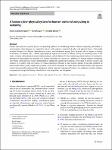Item Infomation
Full metadata record
| DC Field | Value | Language |
|---|---|---|
| dc.contributor.author | Nicole Catherine, Taylor | - |
| dc.contributor.author | Karel, Kruger | - |
| dc.contributor.author | Anriëtte, Bekker | - |
| dc.date.accessioned | 2023-05-25T01:26:21Z | - |
| dc.date.available | 2023-05-25T01:26:21Z | - |
| dc.date.issued | 2023 | - |
| dc.identifier.uri | https://link.springer.com/article/10.1007/s12652-023-04598-6 | - |
| dc.identifier.uri | https://dlib.phenikaa-uni.edu.vn/handle/PNK/8500 | - |
| dc.description | CC BY | vi |
| dc.description.abstract | Human cyber-physical systems present an appealing platform for facilitating human-centered computing, particularly in environments where humans are required to interact with systems comprised of cyber and physical layers. Universally accepted elements of a human cyber-physical system, and interactions among these elements, do not appear to emerge in literature. To address this, a human cyber-physical system architecture is offered, led by the seafaring focus of this study. A human cyber-physical system implementation, called Mariner 4.0, for monitoring motion sickness of seafarers is presented to demonstrate the operation of a human cyber-physical system as a platform for human-centered computing. The human cyber-physical system implementation enabled the digital representation of the state of motion sickness and location of a seafarer, and conveyance of related information through a state monitor display. | vi |
| dc.language.iso | en | vi |
| dc.publisher | Springer | vi |
| dc.subject | human cyber-physical system | vi |
| dc.subject | human-centered computing | vi |
| dc.title | A human cyber-physical system for human-centered computing in seafaring | vi |
| dc.type | Book | vi |
| Appears in Collections | ||
| OER - Kỹ thuật điện; Điện tử - Viễn thông | ||
Files in This Item:

